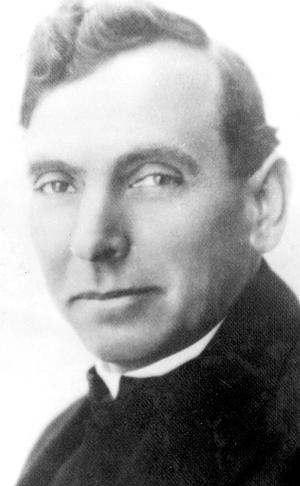Sickly Priest was ‘Great Restorer’ of Mission San Juan Capistrano
“His rebuilding of the mission was worthy of the heroic padres who had founded it on the wastelands...”


In 1910, Mission San Juan Capistrano was placed under the care of Father St. John O’Sullivan, a 36-year-old priest from Louisville, Kentucky. Father O’Sullivan was released from regular duties in his diocese because he had contracted tuberculosis and was not expected to live for more than a few years. He headed to California, via Texas and Arizona, in search of a more moderate climate in which his health might improve. Fate led him to Mission San Juan Capistrano, which hadn’t had a resident pastor since 1886.
According to historical accounts, at the time he arrived the mission was “ruined, despoiled and apparently useless.” Weeds were overgrown, walls defaced and adobe structures crumbling; the chancel-dome of the Great Stone Church was covered with the mud nests of swallows and the little church in which Father Junípero Serra once celebrated Mass served as a grain warehouse for a nearby farmer. Cause for despair for some, but not Father O’Sullivan. As his biographer Henry Bedford-Jones wrote, “Here awaited him overgrown and forgotten graves. The place appealed to him, it was like himself, whose body was gone in decay.” Seeing its great potential, Father O’Sullivan methodically went to work on the mission’s restoration.
He put up a makeshift tent to serve as his rectory (the former priest’s residence was infested with insects) and began collecting pieces of old tile, square iron nails, bricks and any other building materials of the mission era which lay among the ruins. More was needed, so, in what seemed folly to local townspeople, Father O’Sullivan purchased new construction materials and traded with ranchers and farmers for old. When it came time for painting, he was not satisfied with modern paint colors, but insisted on a mixture used at the time of the mission’s founding. Besides being a priest, Father O’Sullivan was an artist, and was adamant that only mission-era materials and building techniques he used in the restoration effort. As Bedford-Jones explained, “There are two beings who will never compromise with this world, one is the priest, the other is the artist. Both in this man, were one.”
Father O’Sullivan learned the language of the local townspeople, and many aided him in his preservation efforts. He quickly became a welcome visitor in their homes, and they related to him the many old stories and legends of the missions. (He would later incorporate these tales into his Little Chapters book.)
As the restoration continued, Father O’Sullivan hired Mexican laborers to build a wall around the mission grounds in the same manner as their ancestors did nearly a century and a half before. When the wall was complete, tourists were charged an admission fee to continue funding mission preservation.
He hired a sculptor to create a statue in tribute to the mission’s founder, Junípero Serra, which today stands near the mission’s entrance. He himself served as a model for Serra’s face. In 1922, Bishop Cantwell of Los Angeles contributed a beautiful, 300-year-old Golden Altar for the Serra Chapel, a development in which Father O’Sullivan took particular delight.
By the time of his death in 1933, the mission was welcoming large numbers of visitors each year brought by the new highway which ran nearby. Pastors who succeeded Father O’Sullivan have continued the work “the Great Restorer” of the mission began. Historian Msgr. Francis Weber affectionately remembers the contribution of the venerable priest in his The Pilgrim Church in California: “His rebuilding of the mission was worthy of the heroic padres who had founded it on the wastelands … (when Father O’Sullivan died) Southern California lost a holy priest, a great man, a high-minded citizen.”
- Keywords:
- mission san juan capistrano














